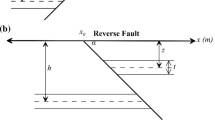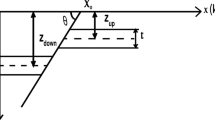Abstract
The inverse problem of estimating parameters (e.g., size, depth) of subsurface structures can be considered as an optimization problem where the parameters of a constructed forward model are estimated from observations collected on or above the Earth’s surface by minimizing the difference between the predicted model and the observations. Traditional solutions based on gradient-based approaches applied to nonlinear and non-unique problems basically depend on the initial conditions and may not always converge to the global minimum of the cost function if the starting model is far away from the true model. Alternatives to these straightforward approaches are innovative methods such as random search techniques that operate directly on the nonlinear models. This study compares a Monte-Carlo optimization method called Simulated Annealing (SA) to the Least-Squares Solution (LESS) within the general Gauss-Helmert formulation to estimate the parameters of a dip-slip fault from gravity gradient measurements as might be collected on profiles surveyed by an airborne system. It is shown that the SA algorithm is a more robust technique with respect to initial conditions in that it proceeds more comprehensively in parameter space and converges to their true values and thus the global minimum of the cost function. The SA algorithm is able to estimate the parameters of the fault as well as or better than LESS, and in the presence of significant background geologic and observation noise.
Similar content being viewed by others
References
Baselga S., 2007. Global optimization solution of robust estimation. J. Surv. Eng., 133, 123–128.
Baselga S. and Asce M., 2011. Second-order design of geodetic networks by the simulated annealing. J. Surv. Eng., 137, 167–173.
Bell Geospace, 2008. Final Report of Processing and Acquisition of Air-FTG Data in Vinton Dome, Louisiana. Bell Geospace, Inc., Houston, TX.
Corana A., Marchesi M., Martini C. and Ridella S., 1987. Minimizing multimodal functions of continuous variables with the “Simulated Annealing”. ACM Trans. Math. Softw., 13, 262–280.
Ge Y.W., Kang S.Z., Ling D.G., Chang W.F., Liang H.X. and Zhong S.S., 2008. An algorithm of fault parameter determination using distribution of small earthquakes and parameters of regional stress field and its application to Tangshan earthquake sequences. Chinese J. Geophys., 51, 569–583.
Geman S., and Geman D., 1984. Stochastic relaxation, Gibbs distribution and the Bayesian restoration in images. IEEE Trans. Patt. Anan. Mac. Intel., 6, 721–741.
Goffe W., Ferrier G.D. and Rogers J., 1994. Global optimization of statistical functions with simulated annealing. J. Econom., 60, 65–99.
Hajek B., 1988. Cooling schedules for optimal annealing. Math. Oper. Res., 13, 311–317.
Hastings W.K., 1970. Monte Carlo sampling methods using Markov chains and their applications, Biometrika, 57, 97–109.
Jekeli C., 1988. The gravity gradiometer survey system. EOS Trans. AGU, 69(8), 105, 116–117.
Jekeli C., 2006. Airborne gradiometry error analysis. Surv. Geophys., 27, 257–275.
Kirkpatrick S., Gelatt C.D. and Vecchi M.P., 1983. Optimization by simulated annealing. Science, 220, 671–680.
Khodabandeh A. and Amiri-Simkooei A., 2010. Recursive algorithm for L1 estimation in linear model. J. Surv. Eng., 137, 1–8.
Kohrn S.B., Bonet C., DiFrancesco D. and Gibson H., 2011. Geothermal exploration using gravity gradiometry- a Salton Sea example. GRC Trans., 35, 1699–1702.
Lenzmann L. and Lenzmann E., 2004. Strenge Auswertung des nichtlinearen Gauß-Helmert- Modells. Allgemeine Vermessungs-Nachrichten, 2, 68–72 (in German).
Metropolis N., Rosenbluth A.W., Rosenbluth M.N. and Teller A.H., 1953. Equation of state calculations by fast computing machines. J. Chem. Phys., 21, 1087–1092.
Mundim K.C., Lemaire T.J. and Bassrei A., 1998. Optimization of non-linear gravity models through generalized simulated annealing. Physica A, 252, 405–416.
Nagihara S. and Hall S.A., 2001. Three-dimensional gravity inversion using simulated annealing: Constraints on the diapiric roots of allocthhonous salt structures. Geophysics, 66, 1438–1449.
Pope J.A., 1972. Some pitfalls to be avoided in the iterative adjustment of nonlinear problems. Proceedings of the 38th Annual Meeting of the American Society of Photogrammetry, 449–477.
Represas P., Monteiro Santos F.A., Ribeiro J., Ribeiro J.A., Almeida E.P., Gonçalves R., Moreira M. and Mendes-Victor L.A., 2013. Interpretation of gravity data to delineate structural features connected to low-temperature geothermal resources at Northeastern Portugal. J. Appl. Geophys., 92, 30–38.
Roy L., Sen M.K., Blankenship D.D., Stoffa P.L. and Richter T.G., 2005. Inversion and uncertainty estimation of gravity data using simulated annealing: An application over Lake Vostok, East Antarctica. Geophysics, 70, J1–J12.
Sambridge M. and Mosegaard K., 2002. Monte Carlo methods in geophysical inverse problems. Rev. Geophys., 40, 1–29.
Schaffrin B. and Snow K., 2010. Total Least-Squares regularization of Tykhonov type and an ancient racetrack in Corinth. Linear Alg. Appl, 432, 2061–2076.
Sen M. and Stoffa P.L., 1995. Global Optimization Methods in Geophysical Inversion. Elsevier, Amsterdam, The Netherlands.
Sharma S.P. and Biswas A., 2013. Interpretation of self-potential anomaly over a 2D inclined structure using very fast simulated-annealing global optimization-An insight about ambiguity. Geophysics, 78, WB3–Wb15.
Snow K., 2012. Topics in Total Least-Squares Adjustment within the Errors-In-Variables Model: Singular Cofactor Matrices and Prior Information. Report No.502, Division of Geodetic Science, School of Earth Sciences, The Ohio State University, Columbus, OH, USA.
Shoffner J.D., Li Y., Sabin A. and Lazaro M., 2011. Understanding the utility of gravity and gravity gradiometry for geothermal exploration in the Southern Walker Lake Basin, Nevada. GRC Trans., 35, 1747–1751.
Teunissen P., 1989. First and second moments of nonlinear least-squares estimators. J. Geodesy, 63, 253–262.
Teunissen P., 1990. Nonlinear least-squares. Manuscripta Geodaetica, 15, 137–150.
van Laarhoven P.J.M. and Aarts E.H.L., 1987. Simulated Annealing: Theory and Applications, Mathematics and Its Applications. Reidel Publishing Company, Dordrecht, The Netherlands.
Vasco D.W. and Taylor C., 1991. Inversion of airborne gravity gradient data, Southwestern Oklahoma. Geophysics, 56, 90–101.
Xu P., 2003. A hybrid global optimization method: The multi-dimensional case. J. Comput. Appl. Math., 155, 423–446.
Wang L., Shum C.K., Simons F.J., Tassara A., Erkan K., Jekeli C., Braun A., Kuo C., Lee H. and Yuan D.N., 2012. Coseismic slip of the 2010 Mw 8.8 Great Maule, Chile earthquake quantified by the inversion of GRACE observations. Earth Planet. Sci. Lett., 335, 167–179.
Author information
Authors and Affiliations
Corresponding author
Rights and permissions
About this article
Cite this article
Uzun, S., Jekeli, C. Comparison of least-squares and simulated annealing to estimate fault parameters from airborne gravity gradiometry. Stud Geophys Geod 59, 21–50 (2015). https://doi.org/10.1007/s11200-014-0712-x
Received:
Revised:
Accepted:
Published:
Issue Date:
DOI: https://doi.org/10.1007/s11200-014-0712-x




